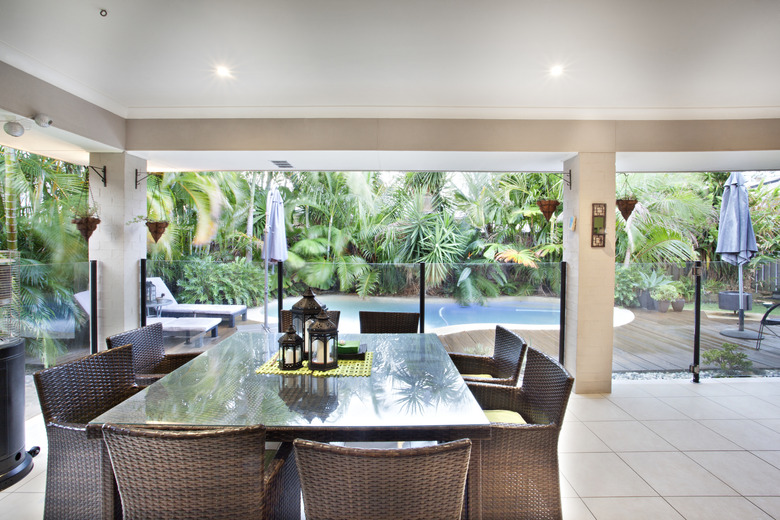What Do You Use To Keep A Glass Table Top Stuck Onto The Frame?
We may receive a commission on purchases made from links.
Attaching a glass top to a table seems like it'd be easy to do, but the transparency of glass makes it tricky. Nonetheless, it's highly recommended you always secure glass, no matter how thick or tempered it may be. Gravity is both friend and foe for an unfixed glass top, and replacing glass tops is common. How to attach the glass depends on the base beneath it and your living needs.
Tip
There are several ways to keep a glass tabletop in place, from silicone adhesives to affordable, easy-to-install hardware. But the best method for you depends on the table base and the glass in question.
Different Scenarios, Different Solutions
Different Scenarios, Different Solutions
Elegant solutions can be difficult when it comes to glass because there's nowhere to hide. But different bases present different problems, such as wood. Wood expands and contracts through the seasons with heat and humidity changes; plus it has a sensitive surface, so adhesives aren't always wise.
Metal and acrylic bases, of course, offer simpler, numerous solutions. But if you ever plan to move, you'll want something impermanent, so you can separate the glass top from the base on moving day.
Movable Solutions to Consider
Movable Solutions to Consider
Temporary solutions only work for tabletops with multiple points of contact on the base. If it's a small base with a large, overhanging glass top, you need a heavy-duty and long-lasting adhesive, something to keep in mind if you're getting creative with base options for a DIY table.
Velcro and bumpers are popular self-adhesive solutions to keep a glass tabletop from sliding. To get the best adhesion, clean the base with rubbing alcohol and allow it to dry thoroughly before applying self-adhesive Velcro or bumpers. Give them a full day to bond with the table surface before putting the top in place.
- Velcro: This made-by-NASA product can affix a glass top that needs to be periodically removed. The trouble is,
unless you can match the Velcro adhesive tape to the table base color, it's
liable to be an eyesore. If you've got a white or black base, matching isn't so
hard to do. - Self-adhesive bumpers: These rubber discs are adhesive on
both sides, offering a semi-permanent solution. They should be removable with
some WD-40 and elbow grease when moving day comes. Available clear and in
multiple colors, bumper adhesive may damage
some wood finishes, but any semi-permanent solution might do so. Be careful to
only touch the sides of the bumpers, or you might notice a big fat fingerprint
in the middle once you've set your glass top in place. - Hardware: A variety of mirror- and glass-mounting clips
provide elegant solutions that can be removed when needed. If the glass is
raised in the clips, you may need to support it with appropriate bumpers in the
middle. - Putty: "Museum Putty" is a popular option but will be
visible and won't have the hold that silicone or polyurethane may have. If you
want your wicker table's glass insert to stop wiggling around, this is a great
and cheap solution.
Permanent Solutions for Glass Tabletops
Permanent Solutions for Glass Tabletops
You'll be installing your glass tabletop on wood, metal, glass, or acrylic. For wood, the best option is a clear, flexible silicone adhesive, which provides a moderate adhesion to the wood and should be sufficient for most installs. But if you need serious grip on both the glass and wood, the pros recommend using a polyurethane adhesive.
For other materials, especially those with smaller contact surfaces between the glass and base, causing large overhangs, then silicone and polyurethane adhesives may do the trick, but there's a strong case for using an industrial epoxy. Some table manufacturers suggest using a two-part epoxy, specifically Loctite 0151 Hysol, which is known for both adhesion and drying to a optically clear finish.
The trouble with using really strong adhesion is you get one go at setting the tabletop in place. Have someone help you, and take the time to prepare in advance. Don't forget, you can mark places on the top of the glass with a dry-erase marker, for easy cleaning afterward. And remember, tempered glass isn't scratch-proof, so be careful while you're working.
